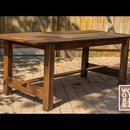Introduction: Epic Wooden PC Case
This was one of the biggest projects I have taken on since I started posting my work on YouTube. I was in the market for a new PC for video editing so I took the opportunity to make something a little more interesting than normal. I decided to make a PC entirely out solid hardwood, with classic joinery, taking into consideration things like component cooling and modern aesthetic. This is my first Instructable so pardon my nubility. Anyways, this is my entry in the Instructables box contest. Thanks in advance for any support.
Onward! The Epic Wooden PC Case
Step 1: Milling and Gluing Up the Panels
The longest part of almost any project working with hardwoods is milling up your boards. The first step is to get all of you boards s4s, square 4 sides. I used my jointer and planer to get to this stage although you could use hand tools if you are on a diet and trying to get more exercise. Once S4S is achieved, for best result arrange your boards to get the desired effect with the grain patterns. Once you are happy with the grain pattern, you can glue the pieces up into panels of sufficient size to work with in assembling the sides of the case. Be sure to orient the glue seems long grain to long grain for best results with the glue. Also be sure to oversize them a little so they can be trimmed up at the table saw, or with a circular saw and a straight edge after they dry. A square straight edge is critical for this kind of joinery. I used biscuit joints on my panels, although these could easily be held together with glue alone, I just used the biscuits to make alignment easier.
The sides, front, and back of the box are made of quarter-sawn sycamore; the top, bottom, and cantilevered section were made out of quarter-sawn cherry.
To minimize wasted material, I glued up the side panel that was going to have a window in it with a gap.
After 24 hours in the clamps and cleaning up the squeeze out, it was time to cut the joinery.
Step 2: Cutting Joinery - Dovetails and Through Tenons
The top and bottom of this case are joined with hand cut dovetails, while the cantilevered bottom is assembled with through tenons in sort of a Japanese style.
Layout carefully for your dovetails, I used a dovetail marking gauge and marking knife to ensure that my angles were accurate and to make sure I transferred the lines accurately from the tailboard to the pin board. I cut my dovetails tails first (western style) this makes transferring the layout a little bit easier.
I cut down to my baseline with a dovetail saw and then cleared out the majority of the waste with a coping saw.
to chisel down to my final baseline, I clamped the panel down to a know straight edge since the panel had bowed a little bit during glue up. I then used the YOLO method to chisel down to a nice crisp baseline.
You can see more about my typical dovetail technique in this dovetail video.
Next I cut the through tenons in the backside of the case. Normally you would cut the mortises first, but in this case that is not possible. Cut the tenons to the desired width then carefully mark out the locations for the mortises. I used a trim router with an upcut bit from CarbideProcessors.com to cut the mortises, leaving a little bit of my marking lines left to allow me to tune the fit with a chisel. Be careful not to put too much pressure on the mortises as you can blow out the other side.
For the tools I used, check out the affiliate links below.
Chisels (I would recommend the modern Stanley Sweethearts for good value chisels [check out my chisel shootout here])
Step 3: Assemble the Case
Now that hopefully all of you joinery was cut smoothly and you have tuned up all of your fits, it is time for the payoff, it is all downhill from here.
Now we have to assemble all of these joints you have now cut.
I used epoxy rather than wood glue so any gaps would be less apparent after the project was finished. I highly recommend West Systems epoxy, but there are lots of good options. With this large of a case and this many joints, you will inevitably have some level of error so give yourself a break.
Affiliate links
Step 4: Carving the Logos - Using Templates to Cut Out for Components
This next step is up to you, but here is where I carved my logo and the logos of the components I was going to be using into the front of the case. I went in depth into how to do this in another video on sign carving free hand with a router so if you want to see how to do that, check out THIS VIDEO.
Next I made some templates for all of the cutouts I needed to make on the case for the 240mm radiator, the motherboard standoff, the reaR I/O plate, the 2 140mm fans, and the power supply. These are all standard sizes so you can get the dimension of these online and just lay them out. Here is where it is very helpful to first mock it up either in Google SketchUp if you are of the computer savvy variety or in cardboard if you need to be able to put your hands on it.
Use these dimensions to make templates you can use with your router with a bearing or a pattern bit.
Affilitate links for the components and tools I used
Step 5: Sanding and Finishing
Finally a sanding and finishing,
I trimmed up all of the extra material on the panels with a flush trim bit, eased over the corners with a 1/4" round over bit and then proceeded to sanding, sanding, and more sanding.
Finally I applied this finish,
For this project I used 3 coats of shellac, sanded to 240 grit between coats, and a buffed out paste wax on top of that for that sheen that just makes you want to touch it.
Affiliate Links
Step 6: Finishing Touches
Finally, the finishing touches,
I used brass gnurled nuts to accent the wood, and a lexan panel for the side window of the PC case. When cutting lexan you want to use the highest tooth count blade you have to avoid cracking the edge, you can then clean up the cut side with a hand plane to give it a smooth finish.
I used some extra motherboard standoffs to pressure fit the front and top fan covers. I drilled a hole that was slightly too small and then forced the hexagonal standoffs into the square holes with a no-marr mallet.
Thanks for checking out this Instructable...umm, vote for me?



